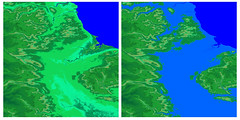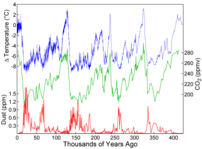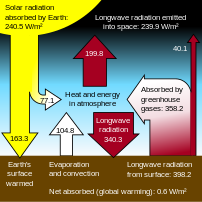
Image via Wikipedia


The world's first empire, known as Akkad, was founded some 4,300 years ago, between the Tigris and the Euphrates Rivers. The empire was ruled from a city—also known as Akkad—that is believed to have lain just south of modern-day Baghdad, and its influence extended north into what is now Syria, west into Anatolia, and east into Iran. The Akkadians were well organized and well armed and, as a result, also wealthy: Texts from the time testify to the riches, from rare woods to precious metals, that poured into the capital from faraway lands.
Then, about a century after it was founded, the Akkad empire suddenly collapsed. During one three-year period four men in succession briefly claimed to be emperor. "Who was king? Who was not king?" a register known as the Sumerian King List asks.
For many years, scholars blamed the empire's fall on politics. But about a decade ago, climate scientists examining records from lake bottoms and the ocean floor discovered that right around the time that the empire disintegrated, rainfall in the region dropped dramatically. It is now believed that Akkad's collapse was caused by a devastating drought. Other civilizations whose demise has recently been linked to shifts in rainfall include the Old Kingdom of Egypt, which fell right around the same time as Akkad; the Tiwanacu civilization, which thrived near Lake Titicaca, in the Andes, for more than a millennium before its fields were abandoned around A.D. 1100; and the Classic Maya civilization, which collapsed at the height of its development, around A.D. 800.
The rainfall changes that devastated these early civilizations long predate industrialization; they were triggered by naturally occurring climate shifts whose causes remain uncertain. By contrast, climate change brought about by increasing greenhouse gas concentrations is our own doing. It, too, will influence precipitation patterns, in ways that, though not always easy to predict, could prove equally damaging.
Warm air holds more water vapor—itself a greenhouse gas—so a hotter world is a world where the atmosphere contains more moisture. (For every degree Celsius that air temperatures increase, a given amount of air near the surface holds roughly 7 percent more water vapor.) This will not necessarily translate into more rain—in fact, most scientists believe that total precipitation will increase only modestly—but it is likely to translate into changes in where the rain falls. It will amplify the basic dynamics that govern rainfall: In certain parts of the world, moist air tends to rise, and in others, the moisture tends to drop out as rain and snow.
"The basic argument would be that the transfers of water are going to get bigger," explains Isaac Held, a scientist at the National Oceanic and Atmospheric Administration's Geophysical Fluid Dynamics Laboratory at Princeton University. Climate models generally agree that over the coming century, the polar and subpolar regions will receive more precipitation, and the subtropics—the area between the tropical and temperate zones—will receive less. On a regional scale, the models disagree about some trends. But there is a consensus that the Mediterranean Basin will become more arid. So, too, will Mexico, the southwestern United States, South Africa, and southern Australia. Canada and northern Europe, for their part, will grow damper.
A good general rule of thumb, Held says, is that "wet areas are going to get wetter, and dry areas drier." Since higher temperatures lead to increased evaporation, even areas that continue to receive the same amount of overall precipitation will become more prone to drought. This poses a particular risk for regions that already subsist on minimal rainfall or that depend on rain-fed agriculture.
"If you look at Africa, only about 6 percent of its cropland is irrigated," notes Sandra Postel, an expert on freshwater resources and director of the Global Water Policy Project. "So it's a very vulnerable region."
Meanwhile, when rain does come, it will likely arrive in more intense bursts, increasing the risk of flooding—even in areas that are drying out. A recent report by the United Nations' Intergovernmental Panel on Climate Change (IPCC) notes that "heavy precipitation events are projected to become more frequent" and that an increase in such events is probably already contributing to disaster. In the single decade between 1996 and 2005 there were twice as many inland flood catastrophes as in the three decades between 1950 and 1980.
"It happens not just spatially, but also in time," says Brian Soden, a professor of marine and atmospheric science at the University of Miami. "And so the dry periods become drier, and the wet periods become wetter."
Quantifying the effects of global warming on rainfall patterns is challenging. Rain is what scientists call a "noisy" phenomenon, meaning that there is a great deal of natural variability from year to year. Experts say that it may not be until the middle of this century that some long-term changes in precipitation emerge from the background clatter of year-to-year fluctuations. But others are already discernible. Between 1925 and 1999, the area between 40 and 70 degrees north latitude grew rainier, while the area between zero and 30 degrees north grew drier. In keeping with this broad trend, northern Europe seems to be growing wetter, while the southern part of the continent grows more arid. The Spanish Environment Ministry has estimated that, owing to the combined effects of climate change and poor land-use practices, fully a third of the country is at risk of desertification. Meanwhile, the island of Cyprus has become so parched that in the summer of 2008, with its reservoir levels at just 7 percent, it was forced to start shipping in water from Greece.
"I worry," says Cyprus's environment commissioner, Charalambos Theopemptou. "The IPCC is talking about a 20 or 30 percent reduction of rainfall in this area, which means that the problem is here to stay. And this combined with higher temperatures—I think it is going to make life very hard in the whole of the Mediterranean."
Other problems could follow from changes not so much in the amount of precipitation as in the type. It is estimated that more than a billion people—about a sixth of the world's population—live in regions whose water supply depends, at least in part, on runoff from glaciers or seasonal snowmelt. As the world warms, more precipitation will fall as rain and less as snow, so this storage system may break down. The Peruvian city of Cusco, for instance, relies in part on runoff from the glaciers of the Quelccaya ice cap to provide water in summer. In recent years, as the glaciers have receded owing to rising temperatures, Cusco has periodically had to resort to water rationing.
Several recent reports, including a National Intelligence Assessment prepared for American policymakers in 2008, predict that over the next few decades, climate change will emerge as a significant source of political instability. (It was no coincidence, perhaps, that the drought-parched Akkad empire was governed in the end by a flurry of teetering monarchies.) Water shortages in particular are likely to create or exacerbate international tensions. "In some areas of the Middle East, tensions over water already exist," notes a study prepared by a panel of retired U.S. military officials. Rising temperatures may already be swelling the ranks of international refugees—"Climate change is today one of the main drivers of forced displacement," the United Nations High Commissioner for Refugees, António Guterres, has said—and contributing to armed clashes. Some experts see a connection between the fighting in Darfur, which has claimed an estimated 300,000 lives, and changes in rainfall in the region, bringing nomadic herders into conflict with farmers.
Will the rainfall changes of the future affect societies as severely as some of the changes of the past? The American Southwest, to look at one example, has historically been prone to droughts severe enough to wipe out—or at least disperse—local populations. (It is believed that one such megadrought at the end of the 13th century contributed to the demise of the Anasazi civilization, centered in what currently is the Four Corners.) Nowadays, of course, water-management techniques are a good deal more sophisticated than they once were, and the Southwest is supported by what Richard Seager, an expert on the climatic history of the region, calls "plumbing on a continental scale." Just how vulnerable is it to the aridity likely to result from global warming?
"We do not know, because we have not been at this point before," Seager observes. "But as man changes the climate, we may be about to find out."
![Reblog this post [with Zemanta]](http://img.zemanta.com/reblog_e.png?x-id=a1910b8e-2631-494c-97ee-a9246fcf9f53)
![Reblog this post [with Zemanta]](http://img.zemanta.com/reblog_e.png?x-id=e32d1fdb-ceea-4c55-a232-7081630b1350)

![Reblog this post [with Zemanta]](http://img.zemanta.com/reblog_e.png?x-id=e15214ec-4d36-4bb6-be95-ad59c59f8ee0)


![Reblog this post [with Zemanta]](http://img.zemanta.com/reblog_e.png?x-id=8e75db0c-0389-4b3e-bb34-f8f92c02f915)

![Reblog this post [with Zemanta]](http://img.zemanta.com/reblog_e.png?x-id=40f39fbe-4f4a-46f5-a764-b9f70c1e75f6)

![Reblog this post [with Zemanta]](http://img.zemanta.com/reblog_e.png?x-id=5ae5ab03-02c2-4b07-82b9-aaaa73db9eb7)
![Reblog this post [with Zemanta]](http://img.zemanta.com/reblog_e.png?x-id=e9ff3079-3328-4a91-a29b-58e6964e5484)

![Reblog this post [with Zemanta]](http://img.zemanta.com/reblog_e.png?x-id=51cb6cfe-e460-4e0d-8e1c-50571f3b92c4)
![Reblog this post [with Zemanta]](http://img.zemanta.com/reblog_e.png?x-id=bb84f256-2481-4ccf-9eae-0a30717665c3)


![Reblog this post [with Zemanta]](http://img.zemanta.com/reblog_e.png?x-id=e5f02f13-139c-42ea-b327-0cd3a70946a5)


![F(t)=Kt+\psi \, \Delta\theta \ln \left[1+{F(t)\over \psi \, \Delta\theta}\right].](http://upload.wikimedia.org/math/e/5/1/e511d72a04c2a74b2bd68e4994ce86ca.png)
![f(t)=K\left[{\psi \, \Delta\theta\over F(t)}+1\right].](http://upload.wikimedia.org/math/d/9/5/d95d5e21b94750e7c75eeb8a918724aa.png)
![Reblog this post [with Zemanta]](http://img.zemanta.com/reblog_e.png?x-id=e57c7b41-fbd7-4a2d-8f43-6497a1ab326b)
![Reblog this post [with Zemanta]](http://img.zemanta.com/reblog_e.png?x-id=820216f8-08f0-4002-993e-fc1976a52a7b)

![Reblog this post [with Zemanta]](http://img.zemanta.com/reblog_e.png?x-id=bba735d8-536f-494f-a289-cc52a2de829f)
![Reblog this post [with Zemanta]](http://img.zemanta.com/reblog_e.png?x-id=2d8e81ec-d6aa-4b94-9130-79bb211968b8)
![Reblog this post [with Zemanta]](http://img.zemanta.com/reblog_e.png?x-id=b184c5c7-c209-4673-8eab-2dcec61653ef)
![Reblog this post [with Zemanta]](http://img.zemanta.com/reblog_e.png?x-id=8c9f0703-a3e9-41d3-9242-8c8547583f78)